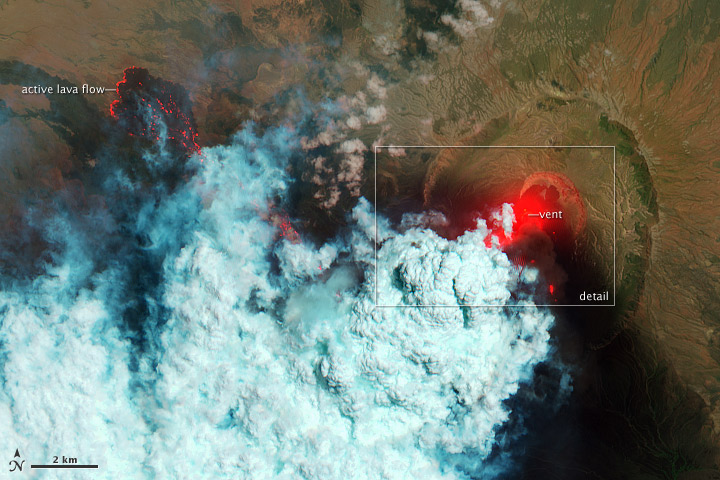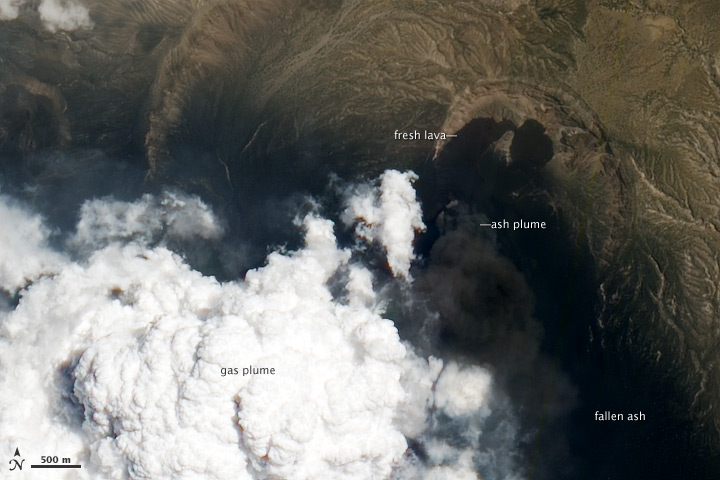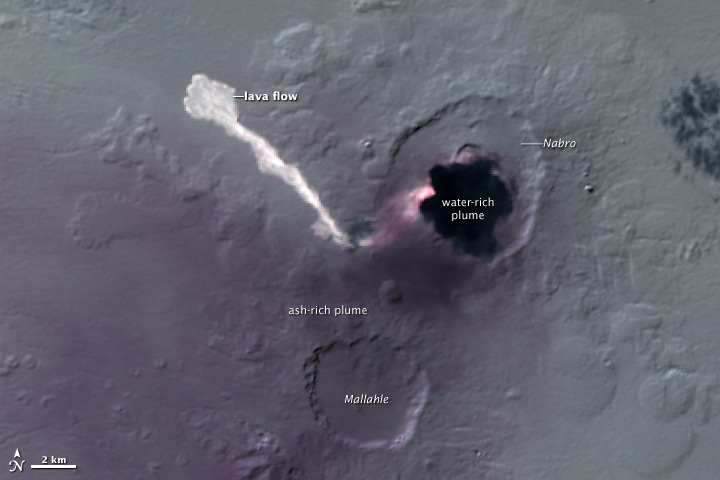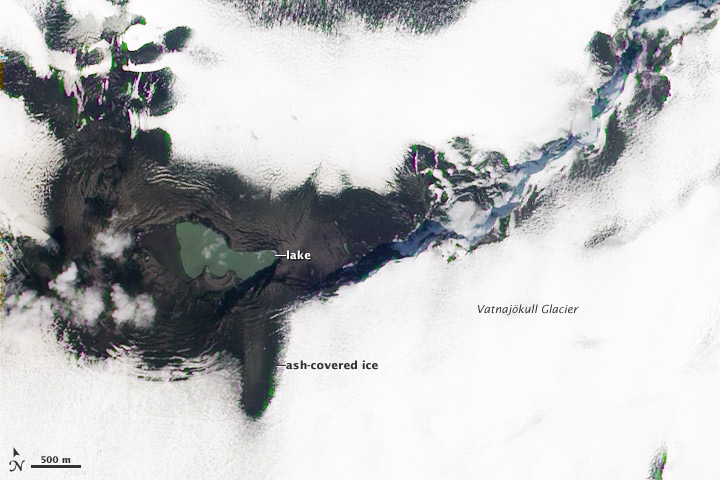NASA: Eritrea - Eruption at Nabro Volcano - Iceland - Eruption of Grímsvötn Volcano - Erupciones de volcanes - 28-07-11
Posted by Ricardo Marcenaro | Posted in NASA: Eritrea - Eruption at Nabro Volcano - Iceland - Eruption of Grímsvötn Volcano - Erupciones de volcanes - 28-07-11 | Posted on 18:15
Open your mind, your heart to other cultures
Abra su mente, su corazón a otras culturas
You will be a better person
Usted será una mejor persona
RM
Abra su mente, su corazón a otras culturas
You will be a better person
Usted será una mejor persona
RM
Eruption at Nabro Volcano
acquired June 24, 2011
Since it began erupting on June 12, 2011, emissions from Eritrea’s Nabro Volcano have drifted over much of East Africa and the Middle East. Ash has displaced residents living near the volcano and disrupted flights in the region. Despite the volcano’s widespread effects, little is known about the eruption. Nabro is located in an isolated region along the border between Eritrea and Ethiopia, and few English-language reports have been published. Satellite remote sensing is currently the only reliable way to monitor the ongoing eruption.
This pair of satellite images are among the first detailed pictures of the erupting vent and lava flows. They were acquired by the Advanced Land Imager (ALI) aboard the Earth Observing-1 (EO-1) satellite on June 24, 2011.
The bright red portions of the false-color image (top) indicate hot surfaces. Hot volcanic ash glows above the vent, located in the center of Nabro’s caldera. To the west of the vent, portions of an active lava flow (particularly the front of the flow) are also hot. The speckled pattern on upstream portions of the flow are likely due to the cool, hardened crust splitting and exposing fluid lava as the flow advances. The bulbous blue-white cloud near the vent is likely composed largely of escaping water vapor that condensed as the plume rose and cooled. The whispy, cyan clouds above the lava flow are evidence of degassing from the lava.
The natural-color image (lower) shows a close-up view of the volcanic plume and eruption site. A dark ash plume rises directly above the vent, and a short, inactive (cool) lava flow partially fills the crater to the north. A gas plume, rich in water and sulfur dioxide (which contributes a blue tint to the edges of the plume) obscures the upper reaches of the active lava flow. Black ash covers the landscape south and west of Nabro.
This pair of satellite images are among the first detailed pictures of the erupting vent and lava flows. They were acquired by the Advanced Land Imager (ALI) aboard the Earth Observing-1 (EO-1) satellite on June 24, 2011.
The bright red portions of the false-color image (top) indicate hot surfaces. Hot volcanic ash glows above the vent, located in the center of Nabro’s caldera. To the west of the vent, portions of an active lava flow (particularly the front of the flow) are also hot. The speckled pattern on upstream portions of the flow are likely due to the cool, hardened crust splitting and exposing fluid lava as the flow advances. The bulbous blue-white cloud near the vent is likely composed largely of escaping water vapor that condensed as the plume rose and cooled. The whispy, cyan clouds above the lava flow are evidence of degassing from the lava.
The natural-color image (lower) shows a close-up view of the volcanic plume and eruption site. A dark ash plume rises directly above the vent, and a short, inactive (cool) lava flow partially fills the crater to the north. A gas plume, rich in water and sulfur dioxide (which contributes a blue tint to the edges of the plume) obscures the upper reaches of the active lava flow. Black ash covers the landscape south and west of Nabro.
References
- Addis Fortune. (2011, June 26). Eritrean Volcano Erupts Economic Mayhem for Ethiopia. Accessed June 27, 2011.
- BBC. (2011, June 14). Eritrea volcano: Ash disrupts air travel in East Africa. Accessed June 27, 2011.
Related Reading
- Nabro (Eruptions).
NASA Earth Observatory image by Robert Simmon, using EO-1 ALI data. Caption by Robert Simmon.
- Instrument:
- EO-1 - ALI
After nearly a week of explosive activity, Eritrea’s Nabro Volcano seems to be evolving toward a milder, more effusive eruption. By June 19, 2011, the altitude of Nabro’s ash plume dropped from a maximum of 45,000 feet (14,000 meters) to 25,000 feet (7,600 meters), according to the Joint Air Force & Army Weather Information Network. The shrinking plume revealed a 15-kilometer (9.3-mile) lava flow, visible in this thermal infrared, false-color image.
The Advanced Spaceborne Thermal Emission and Reflection Radiometer (ASTER) aboard the Terra satellite observed Nabro on the evening of June 19. Hot areas are bright, and cold areas are dark. Thermal infrared data were combined with a shaded relief image to show the terrain. The white feature exending to the northwest is an active lava flow. A high-altitude plume, likely rich in water vapor, is nearly black, and obscures the erupting vents. A diffuse, ash-rich plume to the southwest of Nabro appears purple.
Because the volcano is located in a remote, hard-to-access region, satellite images provide valuable insight into the nature of the eruption. The lava flow fans out in the flat plain, providing a clue that it is probably basalt lava, which is thinner (less viscous) than other types, says volcanologist Eric Klemetti in his analysis of the image. Basalt lava can travel long distances before cooling, thus covering a wide area.
Prior to June 12, 2011, Nabro had not erupted in recorded history. It is unknown when the volcano last erupted. The volcano is one of many along Africa’s Great Rift Valley, which is slowly spreading apart.
The Advanced Spaceborne Thermal Emission and Reflection Radiometer (ASTER) aboard the Terra satellite observed Nabro on the evening of June 19. Hot areas are bright, and cold areas are dark. Thermal infrared data were combined with a shaded relief image to show the terrain. The white feature exending to the northwest is an active lava flow. A high-altitude plume, likely rich in water vapor, is nearly black, and obscures the erupting vents. A diffuse, ash-rich plume to the southwest of Nabro appears purple.
Because the volcano is located in a remote, hard-to-access region, satellite images provide valuable insight into the nature of the eruption. The lava flow fans out in the flat plain, providing a clue that it is probably basalt lava, which is thinner (less viscous) than other types, says volcanologist Eric Klemetti in his analysis of the image. Basalt lava can travel long distances before cooling, thus covering a wide area.
Prior to June 12, 2011, Nabro had not erupted in recorded history. It is unknown when the volcano last erupted. The volcano is one of many along Africa’s Great Rift Valley, which is slowly spreading apart.
References
- Harrington, Ralph. (2011, June 21). Nabro eruption subdued but ongoing. Accessed June 21, 2011.
- Klemetti, E. (2011, June 22). Speculating on the 2011 Nabro eruption in Eritrea. Eruptions. Accessed June 22, 2011.
- NASA Jet Propulsion Laboratory. (2011, June 20). NASA Spacecraft Captures First Recorded Eruption of Volcano in Africa’s Horn. Accessed June 21, 2011.
- Rowan, C. (2011, June 22). Seismo-volcanism in Eritrea. Highly Allochthonous. Accessed June 22, 2011.
NASA Earth Observatory image by Jesse Allen and Robert Simmon, using imagery and elevation data from the NASA/GSFC/METI/ERSDAC/JAROS, and U.S./Japan ASTER Science Team. Caption by Robert Simmon.
- Instrument:
- Terra - ASTER
Eruption of Grímsvötn Volcano, Iceland
After covering a large portion of Iceland with ash in late May 2011, Grímsvötn Volcano left behind a small lake filled with melt water and a hole in the Vatnajökull Glacier. This natural-color satellite image was acquired by the Advanced Land Imager (ALI) aboard Earth Observing-1 (EO-1) on June 11, 2011. The lake covers much of the site of the eruption, with the possible exception of the crescent-shaped feature along the southern shore of the lake. This may be a tephra cone left behind by the eruption. Gray ash covers the ice of Vatnajökull Glacier near the vent. Further away, the ash layer itself is obscured by snow.
Reference
- Institute of Earth Sciences. (2011). Eruption in Grímsvötn 2011. Accessed June 22, 2011.
NASA Earth Observatory image by Jesse Allen and Robert Simmon, using EO-1 ALI data. Caption by Robert Simmon.
- Instrument:
- EO-1 - ALI
NASA: Eritrea - Eruption at Nabro Volcano - Iceland - Eruption of Grímsvötn Volcano - Erupciones de volcanes - 28-07-11
You have an alphabetical guide in the foot of the page in the blog: solitary dog sculptor
In the blog: Solitary Dog Sculptor I, the alphabetical guide is on the right side of the page
Thanks
Usted tiene una guía alfabética al pie de la página en el blog: solitary dog sculptor
En el blog: Solitary Dog Sculptor I, la guia alfabética está en el costado derecho de la página
Gracias
Ricardo M Marcenaro - Facebook
Blogs in operation of The Solitary Dog:
solitary dog sculptor:
http://byricardomarcenaro.blogspot.com
Solitary Dog Sculptor I:
http://byricardomarcenaroi.blogspot.com
Para:
comunicarse conmigo,
enviar materiales para publicar,
propuestas comerciales:
marcenaroescultor@gmail.com
For:
contact me,
submit materials for publication,
commercial proposals:
marcenaroescultor@gmail.com
Diario La Nación
Argentina
Cuenta Comentarista en el Foro:
Capiscum
My blogs are an open house to all cultures, religions and countries. Be a follower if you like it, with this action you are building a new culture of tolerance, open mind and heart for peace, love and human respect.
Thanks :)
Mis blogs son una casa abierta a todas las culturas, religiones y países. Se un seguidor si quieres, con esta acción usted está construyendo una nueva cultura de la tolerancia, la mente y el corazón abiertos para la paz, el amor y el respeto humano.
Gracias :)






Comments (0)
Publicar un comentario